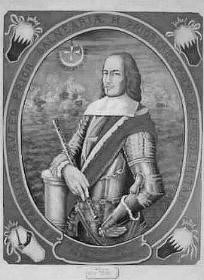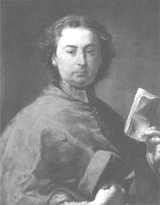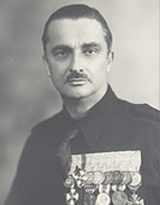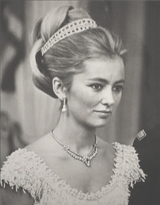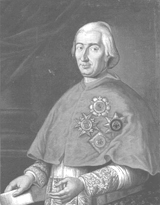
Years in the Roman Curia
Fabrizio Ruffo was born in the castle of San Lucido, a locality in Calabria Citeriore, at the time part of the Kingdom of Naples (currently in the province of Cosenza), on 16 September 1744. Fabrizio was the second-born son of Litterio Ruffo (1704-1772), second duke of Baranello (belonging to the dukes of Bagnara, a side branch of the Ruffo family of Calabria), and his second wife, the Lucanian noblewoman Giustiniana Colonna, princess of Spinoso and marchioness of Guardia Perticara (belonging to a side branch of the Colonna Romano, the ancient Roman family based in Basilicata).
Having moved to Rome as a young man, he took up an ecclesiastical career in 1748 and completed his studies at the Collegio Clementino before going on to La Sapienza University, where he obtained a doctorate in utroque iure (civil and canon law) on 19 September 1767, completing his legal apprenticeship under the lawyers Antonio Bucci and Antonio Maria Gasparri, with whom he collaborated for a short time.
Thanks to the support of his uncle, Cardinal Tommaso Ruffo (then dean of the Sacred College) and of his earlier instructor Pope Pius VI, he first became His Holiness’ domestic prelate in May 1764, and then entered the Roman prelature as tribunal referendary of the Apostolic Signature of Grace and Justice on 17 September 1767. In August 1775 he became commendatory abbot of the Abbey of San Filippo d’Argiro, in the diocese of Gerace, and in January 1781 he became a cleric of the Apostolic Chamber, replacing a relative, Tiberio Ruffo. He later became treasurer-general of the same Apostolic Chamber (14 February 1785), occupying this post for more than ten years together with the post of prefect of Castel Sant’Angelo and commissioner of the maritime fortifications of the Papal States.
Having earned the pope’s full trust, he demonstrated remarkable administrative skills and took on the main responsibility for the policy of financial, fiscal and economic reform called for by Pius VI. In this regard, it is worth remembering that it was him to introduce the measure of ‘customs at the state borders’ (1786).
A ‘forced’ cardinal
Because of the impartiality of his fiscal measures, he was antagonised by the Roman aristocracy, who lobbied the Pope. In 1791 Pius VI, surrendering to the pressure, dismissed the then Monsignor Fabrizio Ruffo from his prestigious post, offering him to become cardinal as recognition and appreciation for his work. And indeed, having become a cardinal under the title of Sant’Angelo in Pescheria on 21 February 1794, he was admitted as a member of the sacred congregations for both Good Government and the Waters and was therefore involved in land administration in the Agro Romano area, in which he showed exceptional ability and openness to modern social and economic theories, despite the closed-doors policy that characterised the Church State at that time.
Among the various buildings that he patronised was the beautiful Church of the Crucifix in Fiumicino. He was also later admitted to the Loreto congregations, and conferred the titles of protector of the Order of Minims of St. Francis of Paola, Conservatory of Divine Providence and of Ripetta, obtaining this position from two laic religious organisations, the Archconfraternities of the Holy Spirit both in the Kingdom of the Two Sicilies, and in the Blessed Sacrament based in Rome at the Basilica of Santa Maria in Cosmedin. He later became patron of the Confraternity of St. Mary of Constantinople and of the Noble College of Wool Clothmakers, as well as of the city of Orte.
Due to his continuously growing popularity even as a cardinal, Fabrizio Ruffo obtained a dispensation from the pope for not receiving minor orders, which he then obtained on 13 January 1795 along with the sub-diaconate and diaconate.
The Army of the Holy Faith
In the same year, however, disappointed by the growing hostility towards him, he decided to leave Rome and return to the Kingdom of Naples, placing himself at the service of King Ferdinand IV of Bourbon, who immediately showed him great esteem, to the extent that he appointed him ‘Superintendent of the Royal Dominii of Caserta‘ and of the manufacturing settlement of San Leucio. At the same time, he also obtained the commendation of the Abbey of Santa Sofia in Benevento.
In January 1799, the Kingdom of Naples collapsed following the unexpected Bourbon expedition to liberate Rome from the French. Having quartered a few dozen kilometres away from Rome, the French army did not stop the Bourbons from entering the city. When the Bourbons unleashed the attack to liberate Rome, the French surprised them with a counteroffensive and chased them during the flee. The pursuit ended in Naples, where the Neapolitan French Republic was created and the tree of liberty was raised.
While Ferdinand IV’s court moved to safety in Palermo, Ruffo moved in defense of religion and of the legitimate sovereign monarch. On his own initiative, he went to Palermo to ask the king for men and ships to reconquer the kingdom. He made a programme that he delivered to the Crown, reading: ‘All papers concerning affairs, both political and military, are requested. We also request the most exact report on the present state of Naples, the papers, the proclamations published there and an account of the events that have recently taken place there. The Cardinal estimates that at least one regiment equipped with cannons should go with him to Calabria. It would be good if, when a sufficient body of troops has been formed, His Majesty would come and take command’.
Having received the title of ‘Commander General’ from the King, Ruffo obtained a ship and seven men. He set sail from Palermo and landed on 8 February in his native Calabria. The first centres for gathering volunteers were Scilla and Bagnara, his fiefdoms. Scores of peasants answered the call, until the number of 25,000 men fit for arms was reached. Ruffo called his army the Armata Cristiana e Reale (today known as the Army of the Holy Faith). Ruffo’s army conquered Crotone, then began the ascent of the peninsula first to Basilicata, then to Apulia (to Altamura and Modugno) and finally to Principato Ultra.
At the head of his army, Ruffo took part in the operations of the Second Anti-French Coalition for the conquest of Naples, which ended victoriously on 15 June 1799. Shortly afterwards, he proceeded to create and appoint the members of the Council of State to uncover and judge the pro-French municipalist rebels guilty of betrayal to the king.
Ruffo was probably the king’s favourite; nevertheless, some reliable sources (Domenico Sacchinelli’s Memoirs and in particular the correspondence between the king and the cardinal) suggest that Fabrizio Ruffo wanted to put his brother Francesco Ruffo on the throne. During his stay in Sicily, the king was afraid that this would happen, and asked Ruffo to send his brother to Sicily to offer him some prestigious positions. It should also be noted that, when in 1806 the king was forced to flee back to Palermo and asked Ruffo to ‘repeat the crusade’, the latter refused on the pretext that ‘those undertakings can only be done once’. The queen, contrary to the king, considered the cardinal unreliable and preferred the English admiral Horatio Nelson.
As Ruffo approached Naples, he had received several written orders from the court of Palermo warning him not to grant honourable surrender agreements. However, the cardinal, true to his style, decided to propose a general pacification anyway. He began negotiations aimed at signing a surrender agreement, before explicit orders arrived. In doing so, he sought, as much as possible, to ease the foreseen sufferings that the Jacobins would have to face, by allowing them to flee, either by embarking or by following the French garrisons that had already left the city.
On June 24, Admiral Nelson arrived in the harbor. The next day, when the first Jacobins were already waiting to embark, the English admiral made it known that the pact was ‘infamous’ and that he would not allow its execution. Cardinal Ruffo was practically stripped of command, and the English officer decided the fate of the Neapolitan prisoners – they were handed over to Bourbon justice, and 124 of them were executed.
Return to the Vatican and his role in the Kingdom of Naples
Following the capture of Naples, Ruffo decided to dispatch companies led by General Gian Battista Rodio to the Roman Republic. This marked the opening move in the invasion of the republican state. With the fall of the Roman Republic, Ruffo headed to the city or Rome (then Urbe) to change his title for that of Santa Maria in Cosmedin on August 11 1800.
In 1801, stepping down as general vicar for the King of Naples, he briefly served as Naples’ minister in Rome before taking up the reins of Giuseppe Bonaparte’s government in the Neapolitan region. In September 1805, he headed back to Naples, intending to leave Rome after Napoleon’s invasion. Following the French troops’ takeover of the kingdom, he sought refuge first in Amelia, Umbria, and then reunited with King Ferdinand IV and his court in Palermo. The king promoted him to the role of ambassador in Paris for Napoleon, leading him to attend the wedding between the French emperor and Archduchess Maria Luisa of Austria on April 2, 1810. This move earned him a place among the ‘red cardinals’ – those not penalized by the emperor, allowed to continue wearing the cardinal’s red attire.
Gaining Bonaparte’s trust, he became part of a commission of cardinals, alongside Aurelio Roverella and Giuseppe Doria, appointed by the emperor to draft a brief outlining the decrees of the Council of Paris on September 20, 1811. He then persuaded the imprisoned Pius VII in Savona to sign the act, receiving the Grand Cross of the Legion of Honor for his efforts. Returning to Rome in May 1814, he received a rather chilly reception from the population and the College of Cardinals. Consequently, he opted to return to Naples, where he established his permanent residence.
Pope Pius VII, grasping the circumstances that led him to collaborate with the French, summoned him back to Rome and appointed him superintendent of Annona and Grascia (managing the supply of meat, fats, and oil) on February 8, 1815. From May 10, 1817, he assumed the role of Grand Prior of the Order of Malta for the Papal State. As the Camerlengo of the Sacred College of Cardinals, he held office from March 29, 1819, to February 21, 1820, when he was named prefect of the Congregation for Waters, Pontine Marshes, and Channels. Returning to Naples in March 1821 amidst revolts against the occupying Austrian troops, on June 27, 1821, in Rome, he chose the diaconate of Santa Maria in Via Lata and was appointed cardinal protodeacon.
During the tumult of the Carbonari uprisings, he was appointed by the King of Naples as a member of the provisional government council, and continued advising the king even after the restoration of full Bourbon power. In August 1823, he took part in the conclave that elected Leo XII, and toward the end of that year, he once again returned to Naples. He passed away in Naples on December 13, 1827, and found his resting place in the family chapel, dedicated to Santa Caterina d’Alessandria, in the Basilica of San Domenico Maggiore in Naples.



